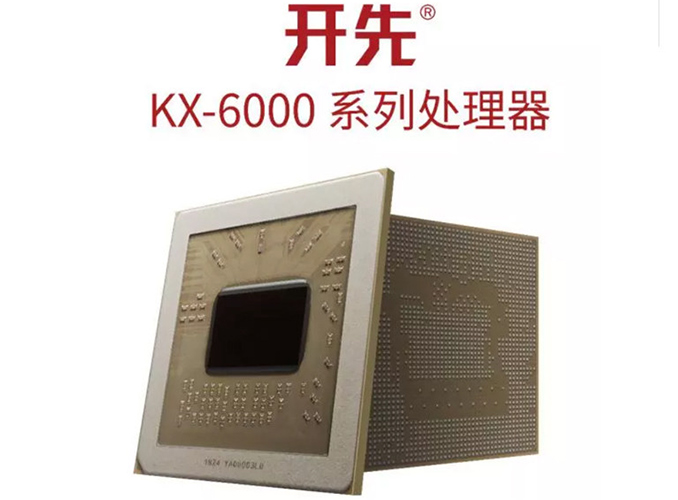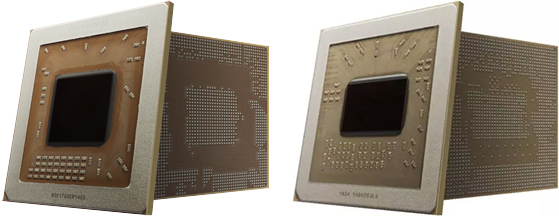Zhaoxin Displays x86-Compatible KaiXian KX-6000: 8 Cores, 3 GHz, 16 nm FinFET
by Anton Shilov on September 24, 2018 12:00 PM EST
Zhaoxin, a joint venture between Via Technologies and the Chinese government, this week for the first time displayed its upcoming x86-compatible CPU, the KaiXian KX-6000. The SoC features eight cores running at 3 GHz and increases performance over its predecessor by at least 50%.
The KaiXian KX-6000 is a successor to the KX-5000 CPU launched earlier this year. Both chips integrate eight-core x86-64 cores with 8 MB of L2 cache, a DirectX 11.1-capable iGPU with an up-to-date display controller, a dual-channel DDR4-3200 memory controller, contemporary I/O interfaces (PCIe, SATA, USB, etc), and so on. The key differences between the KaiXian KX-5000 and the KaiXian KX-6000 are frequencies and manufacturing technology: the former is produced using TSMC’s 28 nm fabrication process and runs at up to 2 GHz, whereas the latter is made using TSMC’s 16 nm technology and operates at up to 3 GHz. Zhaoxin claims that the Kaixian KX-6000 offers compute performance comparable to that of Intel’s 7th Generation Core i5 processor, which is a quad-core non-Hyper-Threaded CPU. Obviously, performance claims like that have to be verified, yet a 50% performance bump over the direct predecessor already seems beefy enough.
As the picture below shows, the thinner manufacturing process enabled Zhaoxin to make the KaiXian KX-6000 die smaller when compared to the predecessor, which will eventually shrink its manufacturing cost. Meanwhile, the two processors use different HFCBGA packaging and therefore cannot use the same motherboards. Meanwhile it is unknown whether the new KaiXian KX-6000 is compatible with Zhaoxin’s USB 3.1 Gen 2-capable ZX-200 chipset.
The Zhaoxin KaiXian KX-6000 relies on the LuJiaZui microarchitecture, which is an evolution of the WuDaoKou microarchitecture that powers the KX-5000 processor introduced in early 2018. Based on what we know today, the LuJiaZui is an x86-64-compatible superscalar, multi-issue, out-of-order microarchitecture that supports contemporary instruction sets extensions like SSE 4.2 and AVX along with virtualization and encryption technologies. Zhaoxin has yet to disclose differences between its LuJiaZui and WuDaoKou designs. Therefore, all we can do is speculate that since the microarchitectures are launched within one year from each other they are very similar, but the newer one has minor optimizations that, perhaps, enable higher clocks, improved caching, better memory support, etc.
Zhaoxin has not announced when it plans to start commercial shipments of its KaiXian KX-6000 processors, as right now it only displays its picture (which proves that it exists). Based on the previously published roadmap, we'd expect the CPU to hit the market in 2019, though when exactly is anyone's guess.
| Zhaoxin's Kaixian KX-5000 and KX-6000 CPUs | |||
| Kaixian KX-5000 WuDaoKou |
Kaixian KX-6000 LuJiaZui |
||
| Core Count | 4 - 8 | Up to 8 | |
| L2 Cache | 8 MB | 8 MB | |
| Frequency | Up to 2 GHz | Up to 3 GHz | |
| ISA | x86-64 | ||
| ISA Extensions | SSE 4.2, AVX | ? | |
| APIC | Yes | ||
| Virtualization | VMX technology, compatible with Intel's VT-X | ||
| Temperature monitoring, overheat protection | Yes | ||
| Power States | C1, C2, C3, C4, P-State | ? | |
| Hardware Encryption Engines | Advanced encryption engine (ACE), SHA-1, SHA-256, SM3/SM4, Randomizer | ? | |
| Security | TXT, EDB | ? | |
| iGPU | DirectX 11.1 feature set. Hardware-accelerated video encoding/decoding. Outputs: DP, eDP, HDMI, D-Sub Max Resolution: 4K Number of Displays: 3 |
? | |
| Packaging | x-ball HFCBGA 37.5 x 37.5 mm |
y-ball HFCBGA 37.5 x 37.5 mm |
|
| Process Technology | TSMC 28 nm | TSMC 16 nm FinFET | |
Related Reading:
- Cypress and Zhaoxin Have USB 3.1 Gen 2 USB Controllers
- China Calling: AMD Forms Joint Venture for x86 Server SoCs in China
- AMD Creates Quad Core Zen SoC with 24 Vega CUs for Chinese Consoles
Source: PC Watch











77 Comments
View All Comments
wumpus - Thursday, September 27, 2018 - link
Cyrix never had a 32 bit license (at least from the 486DLC to the Cx686). They had to have IBM (who had one) fab their chips for them (thus whitewashing the IP). It is possible they managed to pick one up when owned by National (I think some of their chips were fabbed by Ti (who I doubt ever had a 32 bit x86 license)).I don't think Taurus (the Winchip) people had a full license either, but they found a way to produce their chip (and didn't appear to require the fab have a license either, the point was to convince the fab that it was worth making and splitting the chips). Via bought Taurus about the same time they bought Cyrix.
There may have been FTC reasons that forced AMD and Intel to give Via a AMD64 license, but I doubt it.
wumpus - Thursday, September 27, 2018 - link
Looks like there were FTC reasons. Or at least enough to for Intel to make a deal with AMD's IP...PeachNCream - Monday, September 24, 2018 - link
It's pretty cool to hear about China's home grown CPU projects. I owned a Loongson-based laptop a number of years ago that ran Linux off a USB drive (one that was custom fitted to match the shape of the front of the system). It was fun to tinker with and while this is probably part of China's domestic independence effort, I'd be interested in seeing it go on sale in the US. It can't hurt to have a credible third competitor in the CPU market.TheinsanegamerN - Monday, September 24, 2018 - link
China wouldn't have the right patents to sell this here. I HIGHLY doubt the x86 license is legit.KateH - Monday, September 24, 2018 - link
you doubt that VIA has a legitimate x86 license? Im laughing! Google who that is and their product history, Ill wait...wumpus - Tuesday, September 25, 2018 - link
Taurus had one? I know Cyrix didn't: they had to have IBM do all their manufacturing since IBM had a x86 license. There are plenty of "x86" licenses out there (i.e. 16-bit 8086 and 80286), but the only ones that cover 32 bit were Intel, AMD, and IBM. AMD only licensed AMD64 (i.e. 64-bit x86) to Intel and Intel only licensed SSE and AVX to AMD.Taurus *might* have had some means of 32-bit x86 whitewashing that allowed others to fab their winchip: the whole concept was that it should have a better profit fabbing a winchip than SRAM. Then Intel decided to launch a price war against AMD and the winchip was to weak to justify even fabbing it. Thus VIA bought Taurus as well (later VIA chips might have been called Cyrix, but they were based on Taurus designs).
This is pretty much purely pirated (there's no reason to build 8 cores if you don't go 64-bit, and nobody else has a 64-bit license). If they make it into the western world, it will essentially be smuggling (not all that hard through alibaba and ebay, although ebay tries to remove a portion of them).
Zoolook - Wednesday, September 26, 2018 - link
Cyrix originally didn't have an x86 license that's true, but they got a license to some of Intels patents as the fallout from litigation and they got the right to produce x86 chips at any manufacturer who had a crosslicense agreement with Intel, and later they merged with National Semiconductor who had a x-license agreement with Intel.Via then bought out Cyrix from National and entered a crosslicense agreement with them.
It's a very long and strange story filled with litigation, could probably be made into a semiinteresting movie :)
And I think you mean Centaur, not Taurus, Centaur was also picked up by Via, but they never had a license that I know of, they built their WinChip processors on a RISC-design with pretty much no FP throughput at all, they were fabless so I guessed they produced them at foundries with Intel license.
Furthermore Intel and VIA settled a big infringement case in 2003 which included VIA getting a license to develop and build x86 based processors as long as they are not pin- or socket compatible with Intel for 10 years, and it has probably been extended, otherwise Intel would be all over it.
wumpus - Thursday, September 27, 2018 - link
I'd love to know what AMD said when Intel handed VIA a AMD64 license:) I'd assume they aren't allowed to be AMD (socket) compatible either.DigitalFreak - Monday, September 24, 2018 - link
"China wouldn't have the right patents to sell this here. I HIGHLY doubt the x86 license is legit."They've already announced their next CPU and named it after you - UDumFook
Duncan Macdonald - Monday, September 24, 2018 - link
China government + all its associated and/or influenced organisations makes for a fairly big market. China probably has 2 main reasons for getting these chips developed1) Reduce dependence on the USA which has proven an unreliable trading partner with the current president.
2) Have systems without the USA based backdoors of Intel ME or AMD PSP.
If the chips are as good as a first generation Intel i3, then they would be sufficient for the majority of government PCs - if the chips can match current i5 processors then almost all government and commercial PCs could use these chips.
(It would not surprise me to find the chips having a Chinese equivalent of Intel ME to allow easier state snooping.)